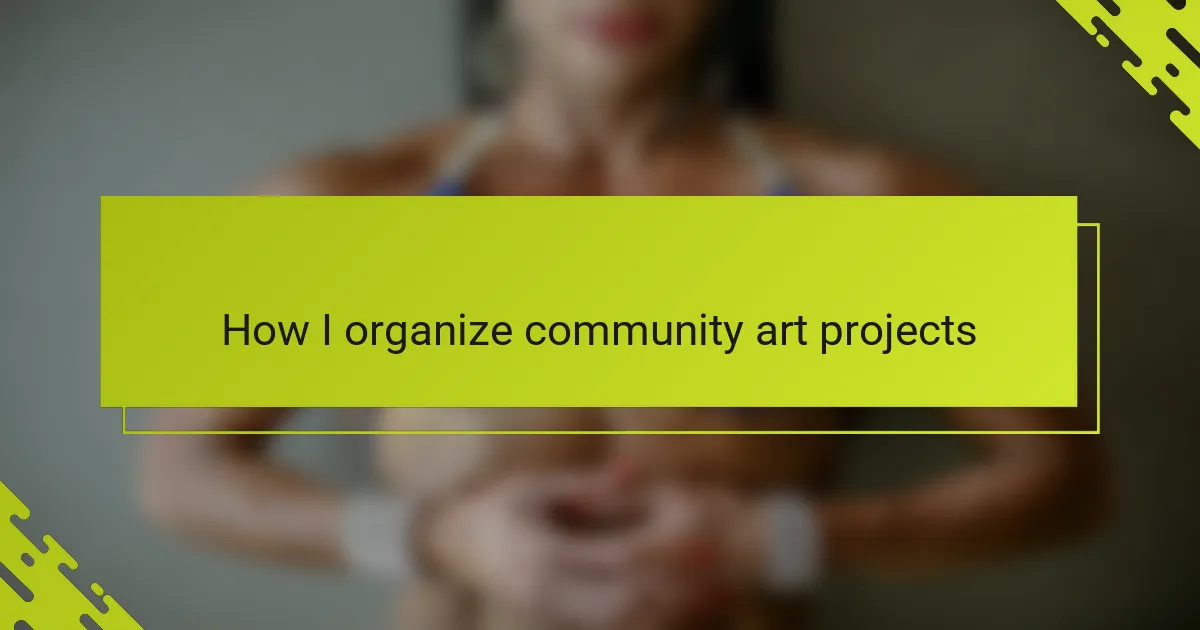Key takeaways
- Community art projects foster connection and empowerment, transforming participants into valued contributors through shared experiences.
- Inclusivity in art planning is essential, involving accessibility and ongoing conversations about what inclusion means to participants.
- Collaboration among artists thrives on open communication and recognizing each member’s unique contributions, turning conflicts into creative opportunities.
- Engaging local communities and documenting outcomes enhance the impact, encouraging ownership and amplifying collective voices beyond the immediate group.
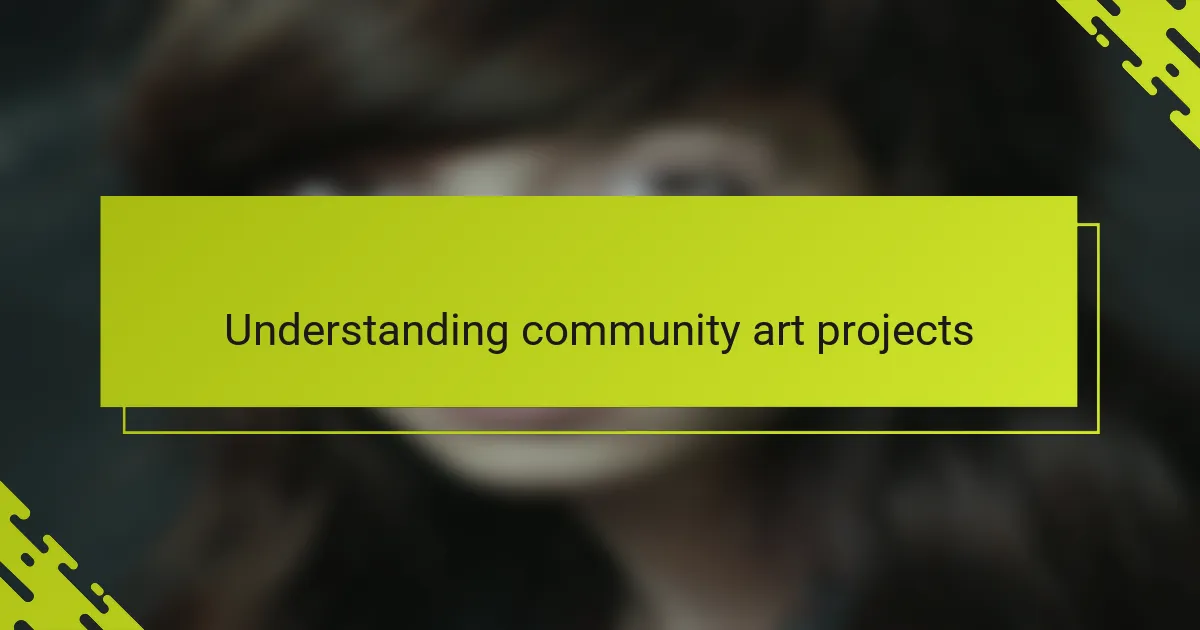
Understanding community art projects
Community art projects are more than just creative endeavors; they are collective experiences that bring people together around a shared purpose. From my experience, these projects have a way of building bridges between diverse voices, creating a space where individual stories blend into a larger, meaningful narrative. Have you ever noticed how a single brushstroke in a mural can speak volumes about a community’s identity?
What makes community art truly powerful is its ability to foster connection and empowerment simultaneously. When organizing these projects, I’ve seen how participants often start as strangers but leave feeling deeply seen and valued. This transformation is what gives community art its unique emotional depth—it’s not just about the final piece but the relationships formed along the way.
Understanding these dynamics is crucial before diving in. Community art requires patience and attentiveness to people’s needs, hopes, and histories. It’s a reminder that art isn’t just created; it’s nurtured within a community’s rhythm and spirit. How can we fully appreciate a project if we overlook the lives that breathe life into it?

Exploring queer women culture themes
Diving into queer women culture themes, I’ve found that these projects become a vital space to explore identity and resilience in ways that mainstream art often overlooks. What strikes me most is how queerness here isn’t just a label but a rich tapestry of experiences, histories, and emotions that demand gentle but honest exploration. How do we create art that honors these complexities without simplifying or generalizing?
In my experience, themes like intersectionality and community care naturally emerge when queer women share their stories through art. For example, during one project, a participant spoke about the healing power of chosen family, which then rippled through the work, weaving a thread of belonging and support. Moments like these remind me that exploring culture isn’t just about representation—it’s about deep connection.
Sometimes, I wonder how often we pause to ask what queer women’s culture truly means to the participants themselves. It’s a question I carry with me every time I organize, ensuring the themes we explore aren’t imposed but arise from collective reflection and lived realities. Isn’t that what makes the art feel authentic and alive?
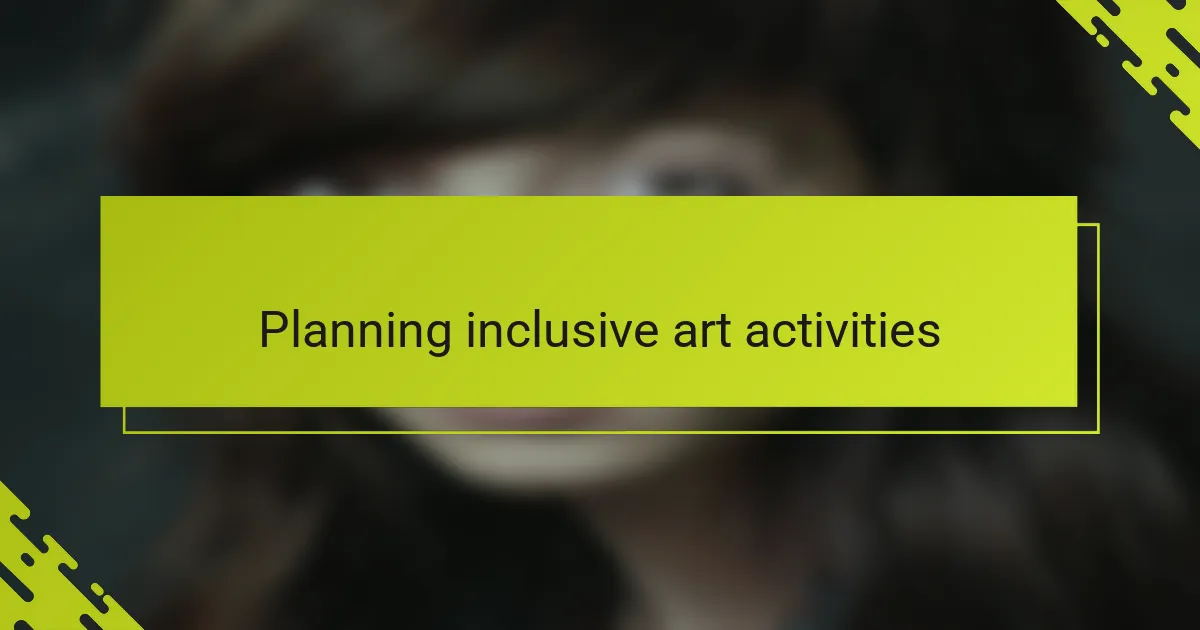
Planning inclusive art activities
When planning inclusive art activities, I always start by thinking about accessibility—not just physically, but emotionally and culturally too. Have you ever noticed how a simple change, like providing various materials or offering different ways to express ideas, can open up creative doors for people who might otherwise feel left out? From my experience, these small adjustments make a huge difference in making everyone feel welcome.
I also find it essential to create space for participants to share what inclusion means to them personally. Once, during a workshop, a participant expressed that inclusion for her was feeling safe enough to take creative risks without judgment. Moments like that highlight how inclusion isn’t a checklist but an ongoing conversation that shapes the activity itself.
Lastly, I ask myself how to structure activities that honor diverse voices without forcing uniformity. It’s a delicate balance — allowing individual expression while fostering group connection. In my work, this often means mixing collaborative projects with personal art-making time, so everyone’s story has room to breathe. Doesn’t that kind of flexibility help art feel more honest and alive?
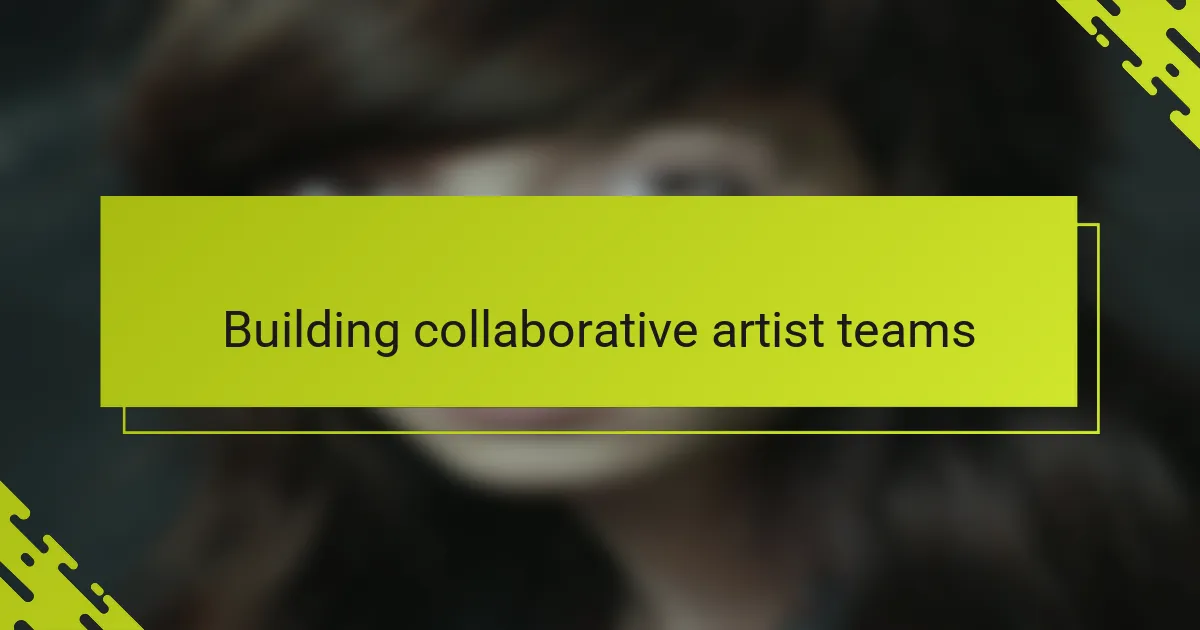
Building collaborative artist teams
Building collaborative artist teams starts with recognizing the unique gifts each person brings to the table. I’ve noticed that when I take the time to listen deeply, revealing these strengths, the team naturally forms a rhythm where everyone feels valued. Have you ever watched a group unlock creativity simply because they trust each other enough to share without fear?
From my experience, fostering open communication is the heartbeat of teamwork. During one project, we set up regular check-ins—not just to discuss progress, but to share feelings and concerns. That space of honesty transformed what could have been tension into opportunities for growth and deeper connection.
But collaboration isn’t always smooth sailing. Sometimes differing visions or styles can clash, and I ask myself: How do we navigate these challenges without sidelining anyone’s voice? For me, it comes down to patience and the willingness to create solutions that honor everyone’s contributions, turning conflict into creative fuel.
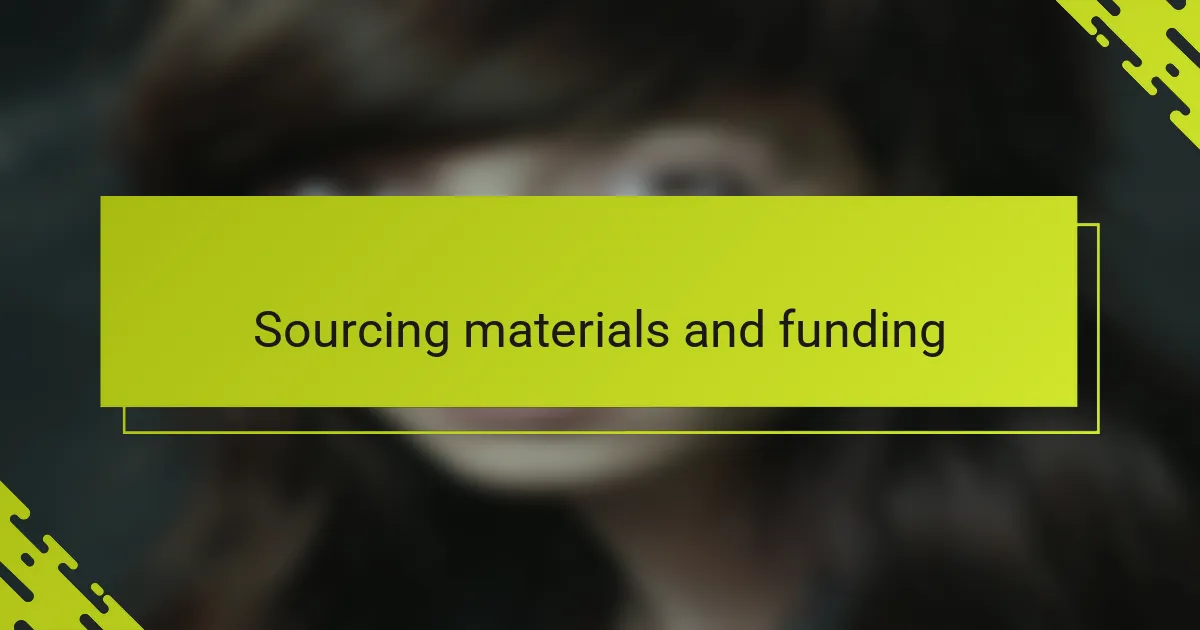
Sourcing materials and funding
Finding materials for community art projects often means getting resourceful. I’ve found that reaching out to local businesses or makers can uncover unexpected donations—everything from scraps of fabric to surplus paints. Have you ever been surprised by how generous people can be when they understand the project’s heart?
Funding, on the other hand, can feel like navigating a maze. Early on, I applied for small grants aimed at grassroots initiatives, which not only helped cover costs but also gave the project visibility. It made me wonder: What if more funding sources prioritized queer women’s creative spaces? That could change the game completely.
Sometimes, community members pitch in by hosting fundraising events or contributing materials themselves. This involvement turns the challenge of sourcing into another layer of collective ownership. When I see people invest their time and resources, it reminds me that the project belongs to all of us, not just to the organizers.
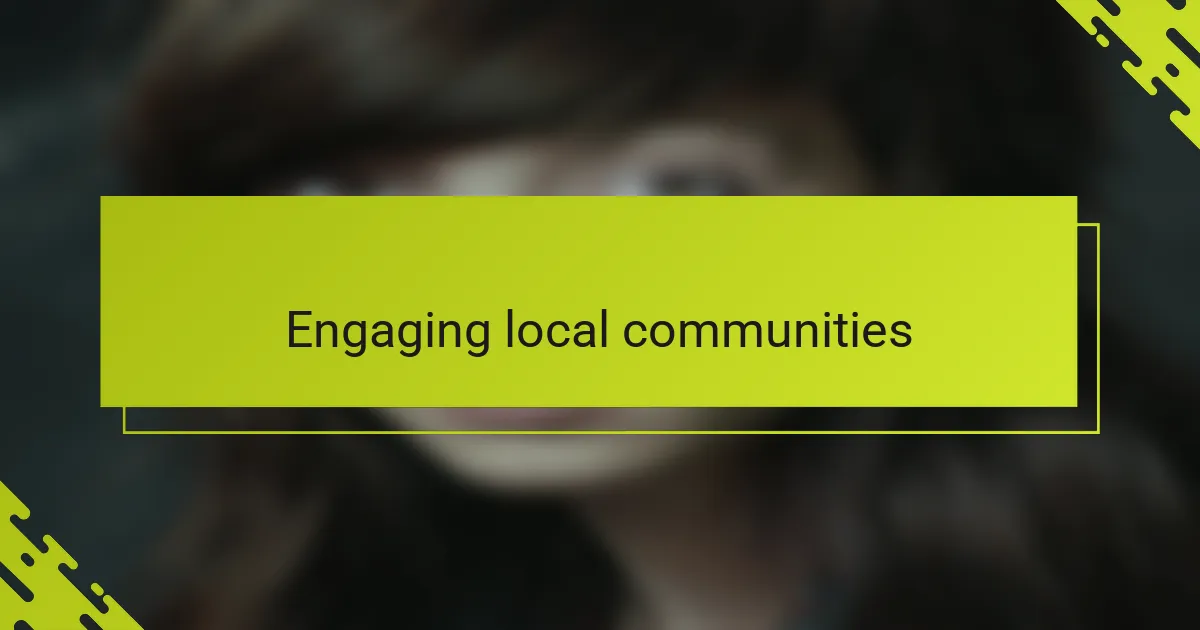
Engaging local communities
Engaging local communities starts with showing genuine curiosity about their stories and experiences. I remember one project where simply hosting an open informal chat before art-making unlocked a flow of ideas and connections I hadn’t expected. Have you ever noticed how people begin to open up when they feel their voices truly matter?
It’s also about creating welcoming spaces where everyone feels comfortable stepping in, no matter their background or experience with art. In my work, I’ve seen shy participants transform into enthusiastic contributors once they realize the project isn’t about perfection but about shared expression. That shift always feels like magic to me.
Lastly, I often ask myself how to keep community engagement sustainable beyond a single event. One approach that’s worked well is empowering local participants to take leadership roles early on, turning a project from something organized for them into something organized by them. Doesn’t that kind of ownership plant seeds for longer-lasting impact?

Documenting and sharing outcomes
Capturing the outcomes of a community art project feels to me like honoring the journey as much as the destination. I always try to document not just the final pieces, but the moments of laughter, hesitation, and connection that unfold along the way. Have you ever looked back at a photo or video from a project and felt it brought you back to that shared energy, those emotions alive on the day?
Sharing these outcomes is more than just showing off the art—it’s about amplifying the community’s collective voice. I’ve found that creating accessible formats, like digital galleries or storytelling sessions, invites people beyond the immediate group to witness and reflect on the work. How often do we pause to consider who gets to see and feel the impact of our projects?
Sometimes I wonder if we can truly capture the essence of such ephemeral experiences. But then, when I hear a participant describe how an artwork helped them feel seen or heard, I realize that even photos, videos, or written reflections become acts of care—preserving the spirit of the project and extending its reach far beyond a single moment.
